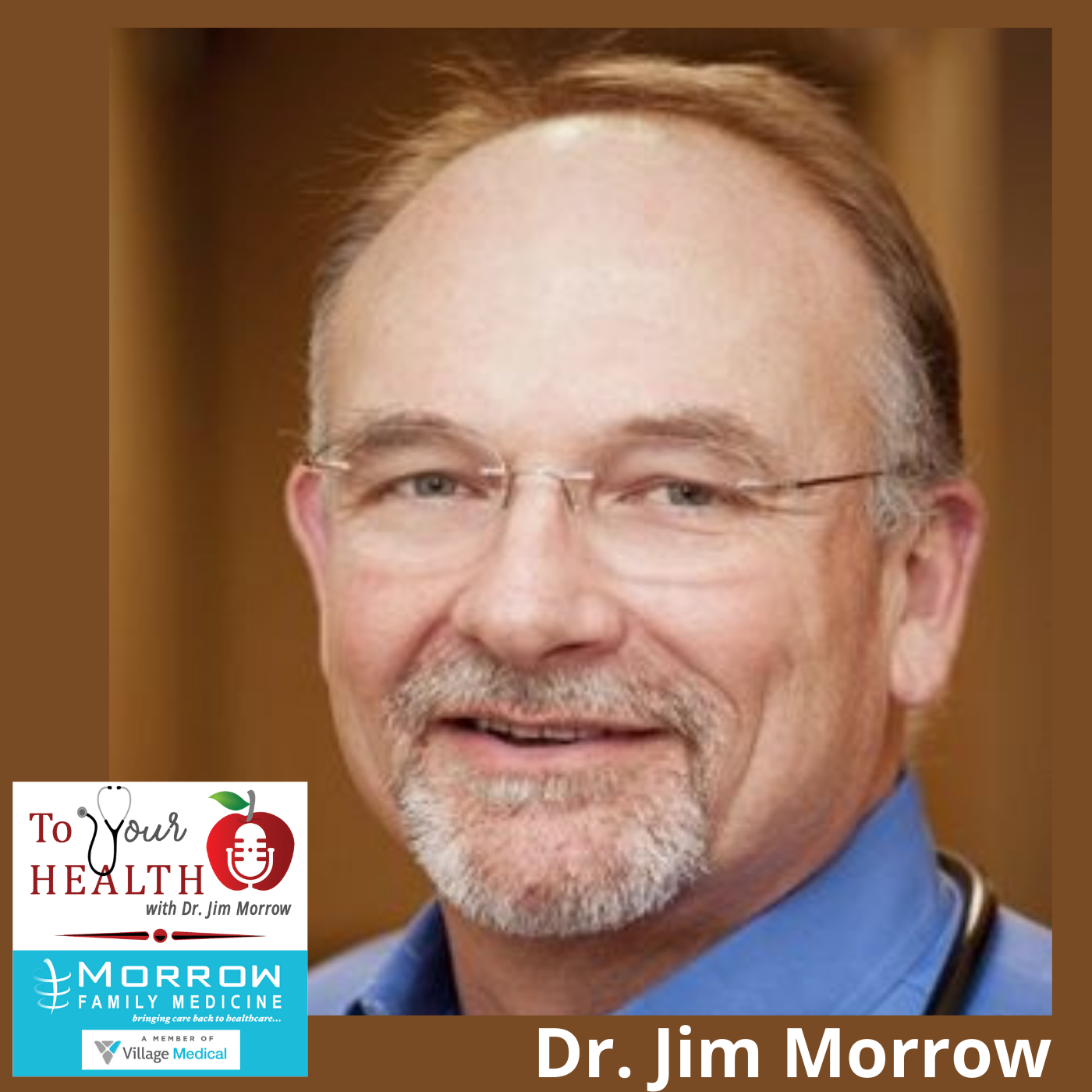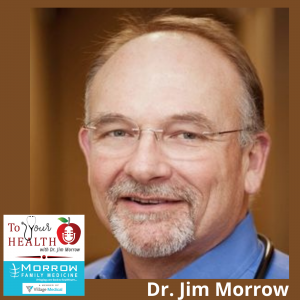
Allergies (Episode 75, To Your Health with Dr. Jim Morrow)
On this episode of To Your Health, Dr. Jim Morrow discussed allergies, which can affect a lot of people in the Southeast U.S. He covered the symptoms, why you would not want to get an x-ray, the best treatments for allergic rhinitis, diagnosing food allergies, the use of an EpiPen and much more.
To Your Health is brought to you by Village Medical (formerly Morrow Family Medicine), which brings the care back to healthcare.
About Village Medical (formerly Morrow Family Medicine)
Village Medical, formerly Morrow Family Medicine, is an award-winning, state-of-the-art family practice with offices in Cumming and Milton, Georgia. The practice combines healthcare information technology with old-fashioned care to provide the type of care that many are in search of today. Two physicians, three physician assistants and two nurse practitioners are supported by a knowledgeable and friendly staff to make your visit to Village Medical one that will remind you of the way healthcare should be. At Village Medical, we like to say we are “bringing the care back to healthcare!” The practice has been named the “Best of Forsyth” in Family Medicine in all five years of the award, is a three-time consecutive winner of the “Best of North Atlanta” by readers of Appen Media, and the 2019 winner of “Best of Life” in North Fulton County.
Village Medical offers a comprehensive suite of primary care services including preventative care, treatment for illness and injury, and management of chronic conditions such as diabetes, congestive heart failure, chronic obstructive pulmonary disease (COPD) and kidney disease. Atlanta-area patients can learn more about the practice here.
Dr. Jim Morrow, Village Medical, and Host of To Your Health with Dr. Jim Morrow
 Dr. Jim Morrow is the founder of Morrow Family Medicine. He has been a trailblazer and evangelist in healthcare information technology, was named Physician IT Leader of the Year by HIMSS, a HIMSS Davies Award Winner, the Cumming-Forsyth Chamber of Commerce Steve Bloom Award Winner as Entrepreneur of the Year and he received a Phoenix Award as Community Leader of the Year from the Metro Atlanta Chamber of Commerce. He is married to Peggie Morrow and together they founded the Forsyth BYOT Benefit, a charity in Forsyth County to support students in need of technology and devices. They have two Goldendoodles, a gaggle of grandchildren and enjoy life on and around Lake Lanier.
Dr. Jim Morrow is the founder of Morrow Family Medicine. He has been a trailblazer and evangelist in healthcare information technology, was named Physician IT Leader of the Year by HIMSS, a HIMSS Davies Award Winner, the Cumming-Forsyth Chamber of Commerce Steve Bloom Award Winner as Entrepreneur of the Year and he received a Phoenix Award as Community Leader of the Year from the Metro Atlanta Chamber of Commerce. He is married to Peggie Morrow and together they founded the Forsyth BYOT Benefit, a charity in Forsyth County to support students in need of technology and devices. They have two Goldendoodles, a gaggle of grandchildren and enjoy life on and around Lake Lanier.
The complete show archive of To Your Health with Dr. Jim Morrow addresses a wide range of health and wellness topics.
Dr. Morrow’s Show Notes
Allergies
- When you hear someone talk about having allergies, usually they mean rhinitis or upper respiratory symptoms (runny nose, watery eyes, itching eyes and ears and nose, sneezing).
- Allergies also can be due to food, medications, animal dander or plants.
Allergic Rhinitis
- The diagnosis of allergic rhinitis should be made when history and physical findings are consistent with an allergic cause
- g., clear rhinorrhea,
- pale discoloration of nasal mucosa,
- red and watery eyes
- and one or more of the following symptoms:
- nasal congestion,
- runny nose,
- itchy nose,
- or sneezing.
- Individuals with allergic rhinitis should be assessed for the presence of associated conditions such as
- asthma,
- atopic dermatitis,
- sleep-disordered breathing,
- conjunctivitis,
- rhinosinusitis,
- and otitis media.
- Specific testing (blood or skin) should be performed for patients with a clinical diagnosis of allergic rhinitis
- who do not respond to empiric treatment,
- or when diagnosis is uncertain,
- or when determination of specific target allergen is needed.
- Sinus imaging should not routinely be performed in patients presenting with symptoms consistent with allergic rhinitis.
- Intranasal steroids should be prescribed for patients with allergic rhinitis whose symptoms affect quality of life.
- Oral second-generation/less sedating antihistamines should be suggested for patients with allergic rhinitis and primary complaints of sneezing and itching.
- Intranasal antihistamines may be prescribed for patients with
- seasonal,
- perennial,
- or episodic allergic rhinitis.
- Oral leukotriene receptor antagonists should not be prescribed as initial therapy for patients with AR.
- Combination pharmacologic therapy may be prescribed for patients with allergic rhinitis who have inadequate response to monotherapy.
- The most effective combination therapy is
- an intranasal steroid
- and an intranasal antihistamine.
- Immunotherapy should be prescribed for patients with allergic rhinitis who have inadequate response to pharmacologic therapy.
- Avoidance of known allergens or environmental control may be considered in patients with allergic rhinitis who have identified allergens that correlate with their clinical symptoms.
- The most effective combination therapy is
Allergy Testing
- There are many types of allergies:
- environmental,
- foods,
- drug,
- An estimated 10% to 30% of the global population has an allergic disease.
- Clinical presentations of allergic diseases, respiratory infections, and autoimmune conditions have similar features.
- Allergy and immunologic testing can help clarify the diagnosis and guide treatment.
- The allergens suspected in an allergy are identified through
- antibody
- or skin testing.
- For patients with an inhalant allergy, skin testing is preferred.
- In patients with food allergies, eliminating the suspected allergenic food from the diet is the initial treatment.
- If this is ineffective, antibody or skin testing can exclude allergens.
- Patients with an anaphylactic reaction to an insect sting should undergo specific antibody or skin testing.
- Skin testing for penicillin can help when penicillin administration is indicated
- and there are limited alternatives.
- Testing for other drug allergies has less well-determined sensitivity and specificity,
- but can guide the diagnosis.
- Patch testing can help identify the allergen responsible for contact dermatitis.
Food Allergies
- Patients with suspected food allergies are commonly seen in clinical practice.
- Although up to 15 percent of parents believe their children have food allergies,
- these allergies have been confirmed in only 1 to 3 percent of all Americans.
- Family physicians must be able to separate true food allergies from
- food intolerance,
- food dislikes,
- and other conditions that mimic food allergy.
- The most common foods that produce allergic symptoms are
- milk,
- eggs,
- seafood,
- peanuts,
- and tree nuts.
- Although skin testing and blood assays may help in the evaluation of suspected food allergies,
- they should not be performed unless the clinical history suggests a specific food allergen to which testing can be targeted.
- Furthermore, these tests do not confirm food allergy.
- Confirmation requires a positive food challenge
- or a clear history of an allergic reaction to a food
- and resolution of symptoms after eliminating that food from the diet.
- More than 70 percent of children will outgrow milk and egg allergies by early adolescence,
- whereas peanut allergies usually remain throughout life.
- The most serious allergic response to food allergy is anaphylaxis.
- It requires emergency care that should be initiated by the patient or family using an epinephrine auto-injector,
- which should be carried by anyone with a diagnosed food allergy.
- It requires emergency care that should be initiated by the patient or family using an epinephrine auto-injector,
- Confirmation requires a positive food challenge
- There are no recommended medications to prevent allergic reactions to food.
- Allergen-specific immunotherapy or immunotherapy with cross-reacting allergens
- is not recommended to treat food allergy.
- Some environmental allergens cross-react with foods, such as:
- Allergen-specific immunotherapy or immunotherapy with cross-reacting allergens
| ENVIRONMENTAL ALLERGEN | CROSS-REACTIVE FOODS |
| Birch pollen | Carrots, celery, fresh fruit (e.g., apples, cherries, nectarines, peaches, pears), hazelnuts, parsnips, potatoes |
| Grass pollen | Kiwi, tomatoes |
| Ragweed pollen | Bananas, melons (e.g., cantaloupe, honeydew, watermelon) |
Nonallergic Rhinitis
- Chronic nonallergic rhinitis encompasses a group of rhinitis subtypes
- without allergic or infectious etiologies.
- Although chronic nonallergic rhinitis represents about one-fourth of rhinitis cases and impacts 20 to 30 million patients in the United States,
- its pathophysiology is unclear
- and diagnostic testing is not available.
- Characteristics such as no evidence of allergy or defined triggers help define clinical subtypes.
- There are several subtypes with overlapping presentations, including:
- nonallergic runny nose,
- senile or geriatric rhinitis,
- gustatory rhinitis,
- drug-induced rhinitis,
- hormonal rhinitis, and
- occupational rhinitis.
- Treatment is symptom-driven and similar to that of allergic rhinitis.
- Patients should avoid known triggers when possible.
- First-line therapies include
- intranasal corticosteroids,
- intranasal antihistamines,
- and intranasal ipratropium (a drying agent).
- Combination therapy with decongestants and first-generation antihistamines can be considered
- if monotherapy does not adequately control symptoms.
- Nasal irrigation and intranasal capsaicin may be helpful but need further investigation.















